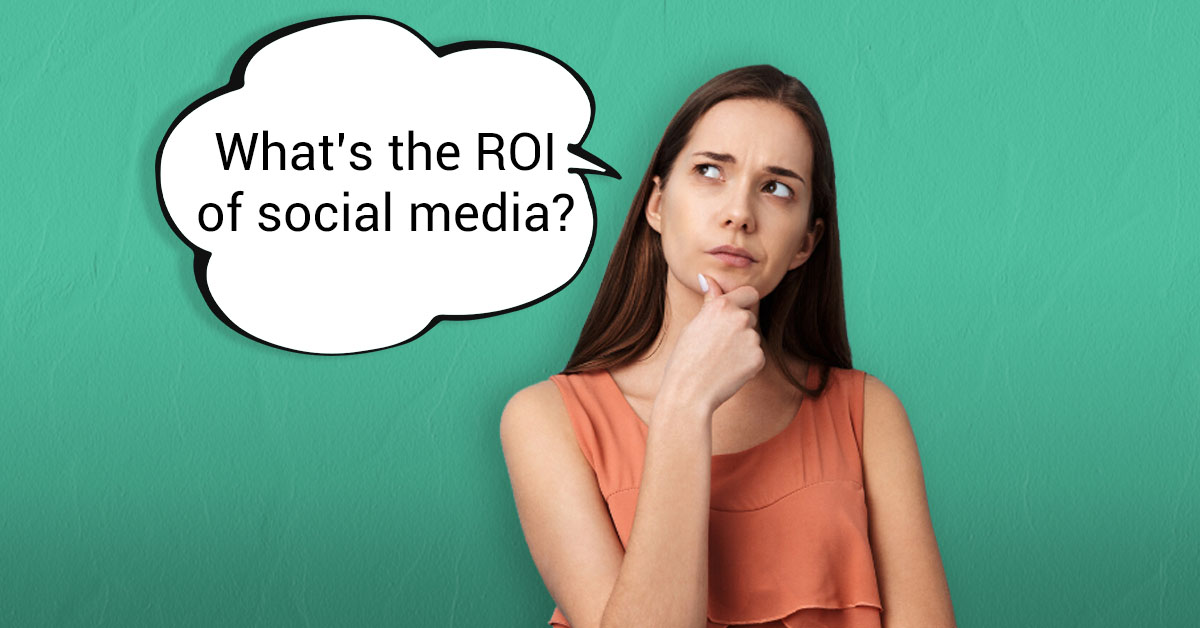As a business owner, you deserve to know the return on investment from your marketing efforts — including money spent on social media marketing. You also deserve to understand the complexities of social media metrics and ROI.
We’ve coached thousands of business owners on social media and ROI.
More often than not, they come to us with a mindset of “I don’t care about anything else — all I want is new leads, sales, members, customers or employees from social media.”
Consider how you get customers in the real world, however.
Standard human behavior dictates that most customers have to move through a traditional marketing funnel. Guess what? It’s no different online.
As powerful as social media is, it’s not powerful enough to alter standard human behavior. Potential customers still need to go through each step of your sales process before they decide to buy.
“Social media does NOT replace everything,” explains Mastered Marketing. “I’ve seen people who invest in social media, but then they get lazy. They stop making as many calls. They stop networking. They stop putting in effort, thinking that social media alone will carry them. This isn’t true! And your results will slip, making you think it was social media that didn’t work, but it was actually other factors.”
Traditional ROI Versus Social ROI
To measure your own social ROI, start by considering the different steps in the buying process of a traditional marketing funnel:
- Awareness
- Interest
- Consideration
- Intent
- Evaluation
- Purchase
We’ve tweaked that traditional funnel a bit for purposes of illustrating the social media buying process:
- Awareness
- Interest
- Consideration
- Purchase
- Loyalty
- Advocacy
At each step, different metrics help determine the return on marketing investment. We’ve outlined the steps with their associated metrics below — along with a few action steps that can help you improve your social ROI at each stage of the buying process.
One caveat to keep in mind at all times: A social media user may find you at any step in their own buying journey. They may become aware of your existence through their friend commenting on your team-member Tuesday post. Or checking out your social content and finding out how well you treat your staff may be the tipping point to get them to buy. We recommend checking out our post, Social ROI and the Marketing Ecosystem, for more details on the non-linear nature of social media purchasing behavior.
Step 1: Awareness
Do your prospective customers even know you exist? Or know you offer a specific product or service?
Social ROI = new followers, impressions, reach and video views — all of which contribute to awareness of your brand.
Let’s unpack those two terms: impressions and reach.
- Impressions are simply the number of times a post appears in someone’s timeline. It could be the same Facebook user viewing your content multiple times.
- Reach is the number of unique viewers your post has — i.e., not only your own followers, but also those people’s friends and others who aren’t yet following you.
What you can do to generate awareness:
- Run a page promotion campaign to get more followers.
- Give them something to see when they get to your page. Highly engaging content (more on that in the next step) that showcases your products and services helps to improve awareness of what you have to offer.
- Boost your content to ensure it gets seen by a wider audience. More of your followers and their extended network will see your content if you boost it.
Step 2: Interest
Now that they know about you, do your prospective customers care about you? Are you interesting to them?
Social ROI = engagement on content and the number of direct messages you receive.
Engagement, a Fancy Word for Audience Interaction
The frequency and manner in which your audience interacts with your account create your engagement metrics. Boiled down even further, good engagement looks like this:
- A high number of likes, comments, shares, clicks and other actions users take after seeing your post. The higher your number of engagements, the better your audience “health.” That is to say, a healthy audience is responsive and consists of real followers who engage with your brand. To have this type of audience, your content needs to be hyper-local, interesting, useful, funny or some combination of those qualities. It also needs to be boosted to improve the reach of that content.
- A high post engagement rate. The number of engagements, divided by the impressions or reach (the number of times someone sees your content), equals your post engagement rate. Quality content, as described above, is more likely to generate a high post engagement rate because it inspires an engagement.
What you can do to generate interest:
Post highly engaging content. You need to post content that not only builds awareness of your business, but also gives people a reason to care.
The best example to illustrate what “highly engaging content” looks like is the difference between a stock photo and a real photo from a business. Which one are you likely to interact with? Most people would much rather see a real photo of a business owner, employee or customer engaged in the day-to-day of your business than a stock photo of a random person doing boring things.
Read our post, Facebook Ads and Hyper-Local Content, for more ideas of posts that will help create interest for your brand.
Step 3: Consideration
Something you posted got them intrigued and they want to learn more about your product or service.
Social ROI = Clicks from social content to your website or landing page as well as new leads.
What you can do to generate consideration:
- When you post your highly engaging content, include a link to your website or landing page.
- Include a call-to-action button on your page, like Shop Now or Book Now. Facebook offers several different options along with call-to-action ads that can help with lead generation.
- Run a lead-generation campaign through Facebook.
Step 4: Purchase
The golden goose! Someone knows about you, reads all your reviews, likes the way you run your business, and likes your offering and price. Cha-ching!
But wait … how are you tracking purchases that come through social media? Do you have a specific offer or code only given on Facebook and Instagram? Do you ask and track, in an organized way, where your customers found you, and if so do you track the amount of those transactions?
Social ROI = Cold hard cash tracked through a code.
What you can do to generate and track purchases:
- Run a Facebook offer with a PLU code tied to your POS system or your payment processor.
- Boost these offers.
Step 5: Loyalty
Just as important as getting new customers is keeping your current customers happy and coming back for more! As Retention Science reports, “According to the Gartner Group, 80 percent of your future profits will come from just 20 percent of your existing customers. That means the revenue sources you’ve been trying to find are most likely sitting right under your nose, waiting to be nurtured and cultivated.”
Social ROI = new online reviews and Facebook Top Fans.
What you can do to generate loyalty:
- Track your online reviews and respond to them. Whether positive or negative, every review should get a response.
- Make offers and content just for your Top Fans. Hello, loyal customers!
Step 6: Advocacy
There’s a difference between being a customer and being a raving fan. You want customers that can’t help but shout your name from the rooftops. Those Top Fans you’ve been nurturing can become your greatest advocates.
Social ROI = advocacy posts, mentions and trending hashtags related to your business.
What you can do to generate advocacy:
While Rallio offers specific advocacy tools for loyal employees and customers, you can achieve advocacy in other ways, too. This step is closely tied to loyalty, as you identify and then reward your most loyal fans.
For even greater impact, you can formalize your brand’s advocacy program and tie it in with influencers. Here’s where social ROI gets really interesting as you have people out there helping with every step of the marketing funnel!
Key Takeaway
The ROI of social media combines all steps of the marketing funnel, oftentimes in ways that can’t be measured with exact numbers. You need to master each layer of the funnel to make sure everything is working together to produce your desired outcomes.
If you’re looking for a black and white answer to your social media ROI woes, then you’re looking to fundamentally change the way humans behave and buy. But if you happen to figure that out, please let us know. We’ll pay you a lot of money for your answers.
Read more: 4 Steps to Measure Social Media Success


